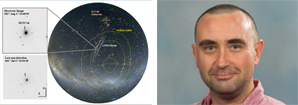Discovery of an Optical Counterpart to a Gravitational Wave Event

Today (Oct 16, 2017) the NSF and LIGO-Virgo and 70 observatories announced the discovery of the optical counterpart to a gravitational wave event. Assistant Professor Dave Sand of the University of Arizona Dept of Astronomy/Steward Observatory made some of the first followup observations (with a 40cm telescope!) of the optical counterpart, never before seen in a gravitational wave event. The era of multi-messenger astronomy has truly begun.
On August 17th, the advanced Laser Interferometer Gravitational-wave Observatory (aLIGO) and Virgo Interferometers, working together, uncovered a new kind of gravitational wave event -- the merger of two neutron stars. This event caused an incredibly tiny disturbance in space which the gravitational wave observatories picked up. Within moments, a gamma ray burst (GRB) occurred. The Fermi space observatory also detected this GRB at the same rough position of the sky as the gravitational wave event. As day turned to night in Chile, many astronomical observatories prepared to observe this region of the sky, hoping to see a long theorized optical signature expected from neutron star mergers, a kilonova resulting from the decay of heavy ions ejected from the collision. This hypothesized kilonova event was expected to be intrinsically ~100 times fainter than a standard supernova, and would only last for a few days before fading away. (Presumably the remnant becomes a black hole, but this is not certain.)
Dr. Sand and his team observed ~50 galaxies that potentially were associated with the neutron star merger, looking for any changes in the galaxies from their previous observations of these same fields as part of the D<40 Mpc (DLT40) supernova survey. Very quickly, the team saw a new star-like object associated with the galaxy NGC 4993 that was not there 20 days previously. At the time of discovery, the new object had an r-band apparent magnitude of about 17, and an absolute magnitude of about -16. The results of the DLT40 study are presented in the Astrophysical Journal and will be available on the arXiv astronomy preprint server on the evening (Tucson time) of Oct 16.
The cover photo shows the LIGO-Virgo error boxes and Fermi error box. The blow-ups show the DLT40 photo (a PROMPT 0.4 meter telescope) of the region three weeks before the gravitational wave, and then 10.7 hours after the gamma-ray burst. We provide a blow-up HERE. That diagram is courtesy Stefano Valenti & Sheng Yang, both at UC Davis. A photo of the DLT40 telescope can be seen HERE. The credit for this latter photo is Dan Reichart, University of North Carolina.
The following text is roughly what Dr Sand plans to say at the Press conference:
"The strategy our team employed to identify the optical counterpart is a straightforward extension of what we do every night, 365 days out of the year, as part of an NSF-funded program to find young supernovae in the nearby universe. We operate a small robotic, 16-inch telescope (basically a souped up amateur telescope) which sits on a mountaintop in Chile — its name is PROMPT and was developed at the University of North Carolina. With this telescope we normally observe 500 galaxies a night that are within our ‘local’ universe, or less than about 140 million light years away. We look at these galaxies night after night after night in order to find supernovae very soon after they explode. Whenever a gravitational wave alert is issued, we cross-match the localization on the sky with the list of galaxies that we normally observe, and set these galaxies to the absolute highest priority. As we have heard, we knew that GW170817 was potentially a special event, and so we spent extra time before the Chilean nightfall, adjusting our software that makes up the telescope schedule each night, as the fields were very close to the horizon as the sun set. In total we looked at about 20 galaxies within the LIGO/Virgo localization, and an additional 30 galaxies that were in the larger Fermi GRB localization, spending about a minute on each field, popping them off one at a time. Everything in our program is automated, and there is almost no human intervention, thanks to the development efforts of Professor Stefano Valenti at UC Davis, and his graduate student Sheng Yang.
We knew very quickly that NGC 4993 had an interesting transient event, because we had observed the same field twenty days earlier (and indeed had been observing the field on average every three days over the last 8 months). Our software flagged it and alerted our team. At the click of a button, we were able to get a second observation of that field to confirm that what we saw was not a glitch or an asteroid, but was indeed a new object in the night sky, which we announced to the community along with the other groups at this table. Even with just our small telescope, we could tell that this transient was unique because of its quickly fading light curve. Also, this program has a bright future -- we could detect this kilonova event even if it was twice as far away with no adjustment to our program -- and so small telescopes can still play a large role in the coming era of multi-messenger astronomy."
HERE is the NASA Press Release. HERE is the NY Times article. HERE is the UANews article. HERE is the AZ Star article.

For Public
Public events include our Monday Night Lecture Series, world-reknowned Astronomy Camp and Mt Lemmon Sky Center.

For Students
A good place to start if you want to become an undergrad major or grad student, or need to find our schedule of classes.

For Scientists
Find telescopes and instruments, telescope time applications, staff and mountain contacts, and faculty and staff scientific interests.




